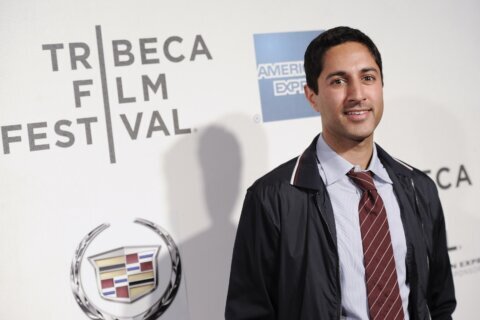HARRISONBURG, Va, (AP) — Harrisonburg-based dancer and teacher Bin-Shin So has quite the story to share, from Taipei, Taiwan to the Shenandoah Valley, via many an international stop, this artist brings decades of skill, experience and passion to the community.
Since 2012 Bin-Shin So, along with her husband and two daughters, has made a home in Harrisonburg. After many years of moving around the world, the family is now settled, and So has become a well-respected mover in the dance community — choreographing local musicals, teaching Ballet and Modern to adults and children, and also serving as a member of the Harrisonburg Dance Cooperative — all steps in a long creative journey that began way back in Taiwan in fourth grade.
When she was a young child, So’s mother opted for her and her sister to attend a boarding school in Taipei. After auditioning, she was granted a place at an exclusive boarding school for training in Peking Opera, a complex traditional Chinese theatrical form that requires intense physical and vocal training from a very young age.
From fourth to sixth grade So and her classmates began their day at five-thirty a.m. with physical training before starting a regular day of schooling at 9 a.m.
“We would do handstands for twenty, sometimes thirty minutes,” Said So. “It was like gymnastics training.”
Once the regular school day had finished it was back to physical and vocal training in the traditional forms, most days until 8 p.m.
This amount of movement training at such a young age creates an extraordinary level of strength and flexibility. For So, it would have been a shame to let the growth fade by ending training too early, so upon moving to a smaller city in Taiwan and having to leave the boarding school, So decided to continue her dance and performance training. So was enrolled in a studio-style middle school. Again merging performance techniques with regular schooling this enabled So to later complete high school at the prestigious National Taiwan Academy of Arts, now named the Taiwan University of Arts.
It was at the Taiwan Academy of Arts during her three years of high school and two years of specializing at the college level that So discovered ballet and studied the cultural exchanges between ballet and Peking Opera in the early 20th century.
“In Peking Opera, everything is inspired by a circle, like a round circle,” she said. “The shapes of the hands and feet. In Ballet it’s about making the line longer.”
Even after five years of the Taiwan Academy of Arts, So was not done with Education and training, then earning herself a place at the Chinese Culture University for another two years, during which she took on her first experiences as a teacher of Chinese dance during cultural exchanges. These experiences were also So’s first journey into the wider world, with classes taking her from the Philippines to Peru.
The work of sharing culture and traveling the world would not end with those classes. After graduating from the Chinese Culture University, So was selected numerous times to work for government-sponsored Taiwanese cultural exchange programs, taking arts, dance, and music around the world in diplomatic and cultural endeavors.
The government cultural exchange program saw So performing in intensive traditional pieces for long periods on international tours, with performances taking the small group of six dancers and musicians from across Europe, South America and Asia, including Malaysia and Singapore
“Sometimes it’s two months of intense training then forty-five-day tours twenty-five shows in that time.” Said So “Sometimes it was every day.”
After several years this schedule, travel itinerary, and the intensity of the movement work began to take its toll.
Dancers endure a great deal of physical strain in their careers, especially at such elite levels, with injuries being commonplace. So herself had a bad injury to her ankle as a young child after landing awkwardly from a jump.
“To this day, I wonder if it was broken,” she said after revealing she was treated for a sprain but suspects it was something worse.
By age 23, So was already reaching the point in many dancers’ careers where they must begin to take notice of the physical effects of so much dance.
“After so many intensive years of dance performances and teaching in Taiwan, it felt like an injury,” she said.
To date, So describes the toll of the intensity of the work and landing many thousands of jumps as having “worn out” her knees and hips.
The realization that the body couldn’t sustain that level of performance brought So to the United States with a place at Lesley College in Boston for Graduate School, studying dance movement therapy.
“It was psychotherapy” explained So,” after that two years of study I worked for another two years as a dance movement therapist. My population was little kids with ADHD — and also I worked 5 days a week with those kids and still worked at weekends as a dance teacher.”
It was in Boston that So met her husband in a Bible study group. A Chinese citizen himself who has a physics degree from Peking University and Ph.D. in history, So’s husband is now a history professor at James Madison University. So describes him as an academic through and through, and to this day they still revel in their different approaches to teaching and learning, finding an interesting mix of academic and kinesthetic practices.
A few short years after they were married in 2004, So arrived at another crossroads in her career.
“After a few years, I got married and had kids, and thought I probably need to step down from dance therapy,” she recalled
Which led to nearly a five-year break from dance in what to date had been an unbroken chain of training, teaching, and performance since fourth grade. There was a period when So thought her relationship with dance was over entirely.
When So’s husband had the opportunity to join the history faculty at JMU in 2012, the family moved to the Valley to settle, and So credits the natural beauty of the area and the community in it with changing her outlook on life.
“This valley encouraged me to really enjoy life more,” she explained.
Once settled just outside Harrisonburg, it would actually be one of her two daughters that brought So back into the world of dance.
“It was my little one. I saw her moving and thought she is a dancer,” So said. “I started looking for somewhere for her to start dance. I couldn’t find anywhere so decided to start teaching her myself.”
So admits to some trepidation in allowing her daughter to follow in her footsteps given the enormous toll dance can take on the body, but with both her children displaying strong artistic talents in both dance and music, So gave space to their passions.
Once the powerful desire to dance had returned, and after settling in the Shenandoah Valley to raise her family there was no stopping So in bringing all of her experience and talent to the people of the community. So began with starting an after-school dance program at Redeemer Classical School in Keezletown, which runs to this day, offering training in Modern, Ballet, Tap, and even Classical Chinese Dance.
“It gave the little kids some variety for recital pieces” So said.
From there her work with children and adults at all levels of experience has expanded further. So recently worked with another Harrisonburg powerhouse of creativity, Joy Anderson, as choreographer for the Eastern Mennonite School production of Godspell, using her experience to bring a subtle mix of Eastern and Western forms to the movement, which created a beautiful and unexpected aesthetic to the physical storytelling in that piece.
So has also found a creative home in the valley with the Harrisonburg Dance Cooperative, a collective of professional dancers founded by Ellie De Waal and Lara Mack to create a space for dancers of all experience levels to learn, perform and practice together.
“It felt great coming back to dance,” said So. “I can finally do something with a professional group again.”
Additionally HDC offers classes to adult beginners, with So acting as one of their primary teachers.
“Not many adults get the opportunity to learn Ballet and Modern,” said So, which is a key reason for the offer from HDC.
After decades of training, from thirty-minute 6 a.m. handstands at boarding school in Taipei to a master’s degree from Boston, to classes in Harrisonburg, Bin-Shin So has collected a lifetime of experience in dance and is a valuable artist asset in the community, bringing not only knowledge but a great open willingness to share the joy of dance with others.
“Dance is something that can cheer you up, not just working out and exercising your body — but also mentally, visually, everything,” she said.
Copyright © 2024 The Associated Press. All rights reserved. This material may not be published, broadcast, written or redistributed.







